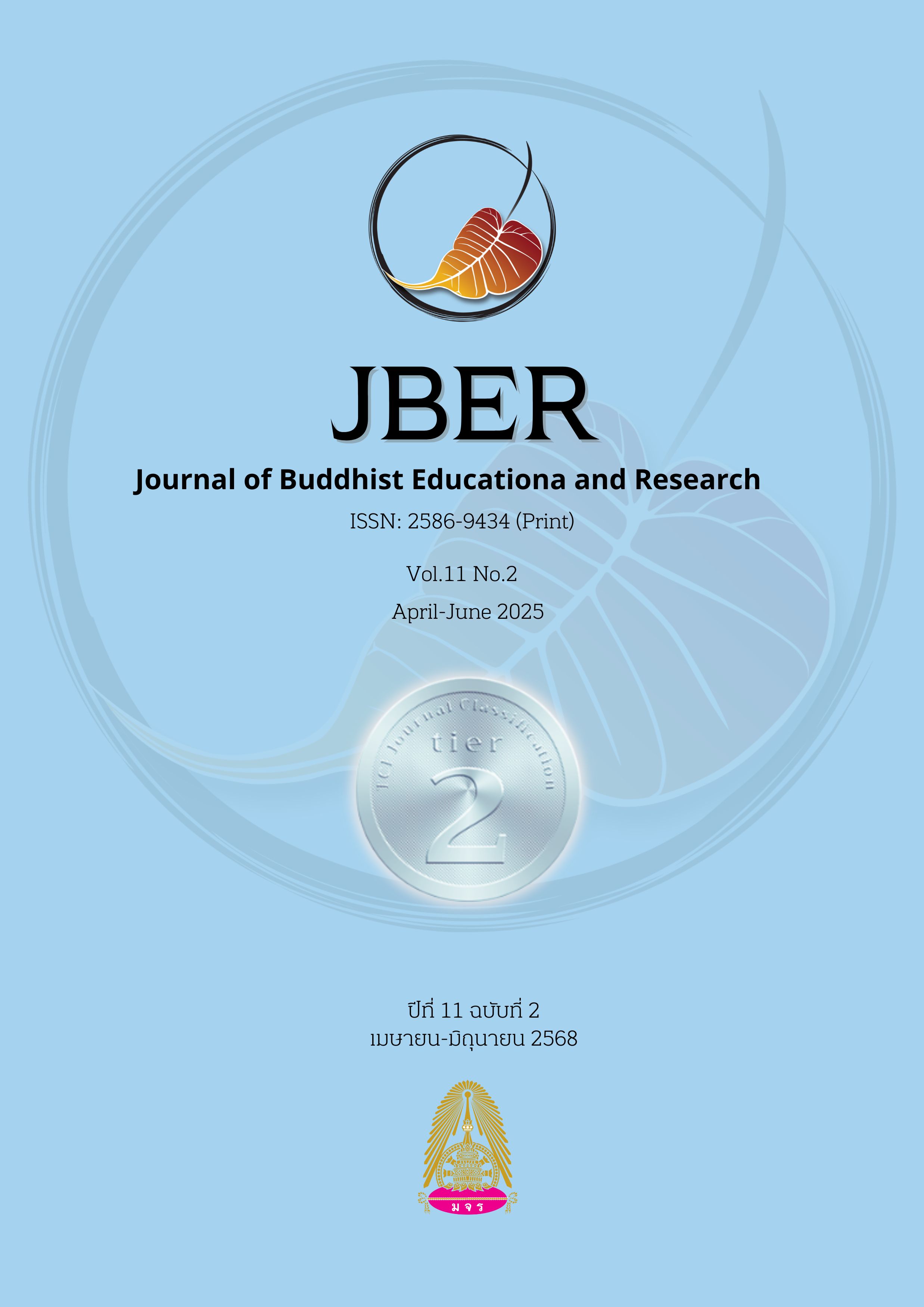ฺBuddhist Administration
Abstract
The book “Buddhist Administration” contains the following contents: 1) Administration has been around since humans first started living together. The best administration is “Buddhist Administration”. The Buddha has established practices called “Sila” or “Vinaya”. In the management of the Sangha, there are three types: self-governance, world-government and Dhamma-governance. 2) Elements of Buddhist administration include self-governance, people management, work management, property management and time management. 3) The characteristics of a Buddhist administrator must have the principles of the Brahmavihāra (the principles for adults), namely, loving-kindness, compassion, sympathetic joy, and equanimity. They must be discerning, intelligent, and have a place to rely on. 4) Buddhist method of planning work decisively from the 5W1H elements: who, what, where, when, why and how. In Buddhist terms, it is called "Daily Buddhist Activities", Buddhist activities that the Lord Buddha performed regularly each day. 5) Buddhism for wise administrators includes the Brahmavihāra, Saṅgahavatthu, Sappurisadhamma, Direction, True Friend, Ten Royal Virtues, Rajasanghavatthu, Imperial Conduct, and Licchavi Parihaniya Dhamma, etc. 6) The Buddhist principles for winning the hearts of colleagues that the Buddha taught are called "Saṅgahavatthu", which include giving, loving speech, helpfulness, and unity. 7) Creating relationships between executives and subordinates: Executives should nurture subordinates and workers, and subordinates or employees should be considerate of their bosses or executives. 8) The most effective Buddhist method of judgment is the combination of facts and values, along with the principles of good people. 9) The Buddhist method of risk management that the Lord Buddha taught to be used in the management of an organization is called “Aparihāniyadhamma”, which includes meeting regularly, meeting together in unison, and not being arbitrary. Those who are adults, respect them, do not abuse their power, do not insult or despise each other, and set up protective measures. 10) The Buddha's clever method of managing knowledge began with the command for his disciples to go out and proclaim Buddhism. 11) Buddhist management method and the method of integration with modern management is called “4M principle” which includes Money, Management, Manpower and Machinery. And 12) Buddhist methods for creating sustainable organizations are considered components of the “Noble Path” and are important in developing the physical and verbal behavior of people to be pure.
References
ณัฐวรรณ ฐิตาคม. (2556). การประยุกต์ใช้พรหมวิหาร 4 ในการบริหารงานของผู้บริหารสถานศึกษา สำนักงานเขตพื้นที่การศึกษามัธยมศึกษา เขต 42 (วิทยานิพนธ์พุทธศาสตรมหาบัณฑิต, มหาวิทยาลัยมหาจุฬาลงกรณราชวิทยาลัย).
ทัศนีย์ สุขทวี, และคณะ. (2559). การบริหารจัดการแหล่งเรียนรู้ตามหลักการบริหาร 4M โรงเรียนในสังกัดสำนักงานเขตพื้นที่การศึกษามัธยมศึกษา เขต 22 จังหวัดนครพนม. วารสารบริหารการศึกษา มหาวิทยาลัยศิลปากร, 6(2), มกราคม–มิถุนายน.
พระครูโกสุมสมณวัตร (สังวาลย์ กุสุโม/เมาตะยา). (2560). ศึกษาหลักสัปปุริสธรรมที่ส่งเสริมการปฏิบัติหน้าที่ของผู้ใหญ่บ้านในตำบลศรีณรงค์ อำเภอชุมพลบุรี จังหวัดสุรินทร์ (วิทยานิพนธ์พุทธศาสตรมหาบัณฑิต, มหาวิทยาลัยมหาจุฬาลงกรณราชวิทยาลัย).
พระครูสมุห์สายัน ยุตฺติโก (จุลปาน). (2560). การเผยแผ่พระพุทธศาสนาของพระธรรมทูตในอำเภอโพธิ์ประทับช้าง จังหวัดพิจิตร (สารนิพนธ์พุทธศาสตรมหาบัณฑิต, มหาวิทยาลัยมหาจุฬาลงกรณราชวิทยาลัย).
พระณรงค์ วุฑฺฒิเมธี (สังขวิจิตร). (2556). การบริหารจัดการตามหลักทุติยปาปณิกสูตรของบริษัท เอ็นอีซี อินฟอนเทียร์ (ไทย) จำกัด (วิทยานิพนธ์พุทธศาสตรมหาบัณฑิต, มหาวิทยาลัยมหาจุฬาลงกรณราชวิทยาลัย).
พระประเสริฐศักดิ์ ธีรธมฺโม (เลาหะปาเลศ). (2561). การศึกษาวิเคราะห์พุทธกิจในการเผยแผ่พระพุทธศาสนาในเมืองสาวัตถี. วารสารมหาวิทยาลัยราชภัฏมหาสารคาม, 12(2), พฤษภาคม–สิงหาคม.
พระมหาตั๋วณฐวัฒน์ ธมฺมธีโร (ถำวาป). (2564). แนวทางการบริหารงานบุคคลตามหลักอปริหานิยธรรม 7 ของผู้บริหารโรงเรียนพระปริยัติธรรม แผนกสามัญศึกษา จังหวัดหนองคาย (วิทยานิพนธ์พุทธศาสตรมหาบัณฑิต, มหาวิทยาลัยมหาจุฬาลงกรณราชวิทยาลัย).
พระมหาบุญมี มาลาวชิโร. (2553). พุทธบริหาร. กรุงเทพมหานคร: ธิงค์ บียอน บุ๊คส์.
พระรณชัย กิตฺติราโณ (ส่งศรี). (2561). การประยุกต์หลักใช้อริยมรรคมีองค์ 8 ในการดำเนินชีวิตของประชาชนในตำบลในเมือง อำเภอเมือง จังหวัดหนองคาย (วิทยานิพนธ์พุทธศาสตรมหาบัณฑิต, มหาวิทยาลัยมหาจุฬาลงกรณราชวิทยาลัย).
พระสุนทร ธมฺมธโร (บุญคง). (2560). การประยุกต์ใช้หลักสังคหวัตถุ 4 ในชุมชนวัดหนองสนม จังหวัดระยอง (วิทยานิพนธ์พุทธศาสตรมหาบัณฑิต, มหาวิทยาลัยมหาจุฬาลงกรณราชวิทยาลัย).
มหาจุฬาลงกรณราชวิทยาลัย. (2539). พระไตรปิฎกภาษาไทย ฉบับมหาจุฬาลงกรณราชวิทยาลัย. กรุงเทพมหานคร: โรงพิมพ์มหาจุฬาลงกรณราชวิทยาลัย.
วรเชษฐ์ โทอื้น, และคณะ. (2566). อารักขสัมปทาเพื่อการดำรงอยู่และส่งเสริมพัฒนาประเพณีของชุมชนภาคอีสานตอนล่าง. วารสารวิชาการรัตนบุศย์, 5(1), มกราคม–เมษายน.
ศศินิภา ระสารักษ์. (2564). ศึกษาทิศเบื้องหน้าในสิงคาลกสูตร (วิทยานิพนธ์พุทธศาสตรมหาบัณฑิต, มหาวิทยาลัยมหาจุฬาลงกรณราชวิทยาลัย).
อรุณลักษณ์ วรินทรพันธุ์. (2565). การบริหารเชิงพุทธของผู้บริหารสถานศึกษาโรงเรียนพระปริยัติธรรม แผนกสามัญศึกษา สังกัดสำนักเขตการศึกษาพระปริยัติธรรม แผนกสามัญศึกษา เขต 7 (วิทยานิพนธ์ศึกษาศาสตรมหาบัณฑิต, มหาวิทยาลัยมหามกุฏราชวิทยาลัย).
Downloads
Published
How to Cite
License
Copyright (c) 2025 Journal of Buddhist Education and Research (JBER)

This work is licensed under a Creative Commons Attribution-NonCommercial-NoDerivatives 4.0 International License.





